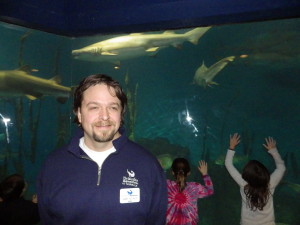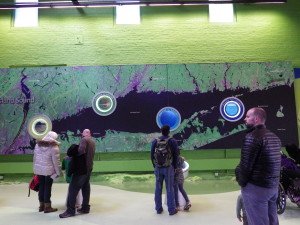Every kid swinging from a grade-school jungle gym knows the old saw about why fish are so smart. They live in schools in case you”™d forgotten.
In a fresh twist at the Maritime Aquarium in Norwalk, seven schools are learning from the fish, so to speak, immersing themselves in the aquarium”™s “Whole School Partnerships” and reeling in results in what the aquarium says is “a demonstrated improvement in standardized test scores closing science achievement gaps.”
Some 130,000 students are among the site”™s 450,000 annual visitors. Impressive as the student number is, it does not include the majority of students the aquarium reaches; its teaching staff of four tours schools in a fleet of five eco-friendly sedans and a mini-van, buckets and cages filled with fauna, more than doubling that number.

The aquarium runs a total 30 education programs from pre-K to high school on an annual operating budget of $1.2 million.
Of the seven Whole School Partnerships participants, Jefferson Science Magnet School, All Saints Catholic School and Brookside Elementary School in Norwalk and Six to Six Interdistrict Magnet School in Bridgeport are already on board, effectively coordinating broad swaths of curricula with Sound research. Three more schools ”” Discovery Magnet School in Bridgeport, Lordship School in Stratford and Winston Prep in Norwalk ”” join the program this year. The aquarium has applied for a $3 million federal grant to take the model national with a decision due this spring.
Said Jamie Alonzo, the aquarium”™s director of education, “We have demonstrated a closing of the achievement gap between ethnic groups, specifically on the science portion of standardized tests. Our ultimate goal is to be authentically relevant as a partner with the public school systems, to help them achieve their goals. We want to leverage this unique resource.”
Last year, 10 Norwalk students from the high school level inaugurated another program, this one specifically after school: the Teen Maritime Program Emphasizing Science & Technology, known by its acronym TeMPEST. It is hoped the program ”” launched with a $26,000 grant from the Fairfield County Community Foundation ”” will eventually expand beyond 100 students, which might be less of a reach than the numbers indicate.

Farmington-based Newman”™s Own Foundation this year stepped up with an additional $150,000 to take the TeMPEST program to the 45-student level, where it is today. Newman”™s funding lasts three years at which point, the vision is for five skill-based cohorts of 20-25 students meeting each day of the week.
“The TeMPEST program is very mission focused,” said Alonzo. “We want to add a cohort for each day of the week bringing the total in the program to as many as 120.” Alonzo is a former education director at the Yale Peabody Museum where he helped develop just such a program. “The Peabody model,” he called it. “We want to move beyond ”˜the sage on the stage”™ and into the realm of inquiry,” he said.
This year witnesses the christening of Spirit of the Sound, the aquarium”™s $2.6 million, 65-foot research catamaran built at the Robert E. Derecktor Inc. shipyard in Mamaroneck, N.Y. It should sail in late May or June, replacing the 40-foot, 34-year-old Oceanic, which will be retired and sold later this year. The Oceanic could accommodate 29 students, while the student contest-named Spirit of the Sound doubles that capacity.
Dave Sigworth, who has handled communications for the aquarium for 21 years, said the overarching subject of the 25-year-old site”™s learning programs was and remains local. In the inquiry learning model as practiced in the “wet labs” and out trawling for live species, students learn about the Long Island Sound and its watershed pretty much exclusively.
Said Sigworth, “One of the things we try to impress on the students is that when you drop that wrapper into a creek and you”™re far inland, all that stuff finds the Sound. It”™s all downhill to the Sound.” Beyond those basics, students might also end up dissecting a squid in the wet lab the aquarium built in 2006 (in the old Hatch & Bailey Co. lumber operation, which is now at 1 Meadow St., Norwalk).
Alonzo said, “The mission of the aquarium is to educate about the Sound and its environs.”
The Sound, it turns out, offers plenty to fascinate. The aquarium”™s Sound-centric displays feature about 300 local species, some of which ”” sizable sand tiger sharks, rays, otters and turtles ”” are as exotic as anything that swam with Jacques Cousteau. Even species one might think mundane ”” flounder and alewives ”” mesmerize from the water instead of from a dinner plate.
The aquarium”™s breadth and depth of programs attract both students and their teachers from throughout New York, New Jersey and Connecticut. The evening of Jan. 15 (4-8 p.m.) witnesses an open house targeting only teachers, administrators and other educators. They will learn what the aquarium offers and how they can tap into its programs. The snow date is Jan. 29.























It should be in an out-of-the-way place in your home
or apartment where there is no danger of being knocked over or
subjected to direct sunlight throughout the day. Each aquarium has its own unique benefits, requirements and
challenges. You want to skim out as much of the Dissolved Organic Compounds (DOCs) before they
can break down in your tank and add to the Green
Hair Algae’s reproduction cycle.